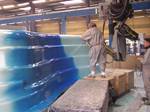The styrene puzzle
CT editor-in-chief outlines two major challenges posed by the recent listing of styrene in the U.S. National Toxicology Program's 12th Report on Carcinogens.
Last summer, as the CT editorial staff discussed what stories to schedule in 2012, we agreed that styrene merited careful scrutiny. The National Toxicology Program (NTP), under the U.S. Department of Health and Human Services (HHS), had just decided in June to list this important crosslinking agent in its 12th Report on Carcinogens (RoC), labeling it as “reasonably anticipated to be a human carcinogen.” The response from the composites industry — before and after the listing — has been loud and angry. The American Composites Manufacturing Assn. (ACMA), in particular, has been active, petitioning the Obama Administration, HHS and Congress with claims that the NTP employed “bad science” in its decision-making.
One of the challenges of covering a story like this (see our result under Editor's Picks," above right) is collecting and making sense of large volumes of data and information. The NTP chemical assessment process is long and complex, and leaves in its wake a trail of reports that is difficult to sort through. Still, one would assume that it wouldn’t be too hard to look at the epidemiological data surrounding styrene and determine, with some conviction, whether or not the NTP was flawed in its decision to list styrene in the RoC. Would that it were that easy.
There are, as I see it, two major challenges surrounding the NTP’s decision to list styrene. The first is specific to the styrene data itself; the second is endemic to the NTP chemical-review process.
Styrene data: Cancer studies of composites industry workers exposed to styrene have tracked almost 100,000 people over decades spanning back to the 1940s. This is great, but the earlier the study was done, the harder it is to determine the amount and duration of styrene exposure by a given worker in a given facility. Further, composites industry workers tend to be transient, thus it’s difficult to determine definitively that one person’s exposure to styrene in one facility for a short period of time caused development of a certain cancer later in life. You’ll find, in the report in this issue, that there is no clear data stream in the cancer studies that shows that styrene is consistently associated with a certain cancer type. That is, one study shows a correlation with one cancer type, while another shows a different carcinogenic correlation.
NTP process: Despite the fact that the NTP is a program based on ostensibly objective scientific exploration, the criteria on which it relies to determine a chemical’s carcinogenic threat is highly subjective. The criteria use phrases like “limited evidence of carcinogenicity,” “causal interpretation is credible,” and “convincing relevant information.” But what one considers limited, credible or convincing can be quite different from what another considers limited, credible or convincing. And like it or not, the ones who matter are those at the NTP, and that organization found a “limited carcinogenic correlation” for styrene.
Getting styrene off the RoC list appears difficult and unlikely — unless new data is developed that clears styrene of its potential carcinogenicity. That won’t stop ACMA and others from trying. We’ll keep you posted.
Related Content
Composite rebar for future infrastructure
GFRP eliminates risk of corrosion and increases durability fourfold for reinforced concrete that meets future demands as traffic, urbanization and extreme weather increase.
Read MoreSulapac introduces Sulapac Flow 1.7 to replace PLA, ABS and PP in FDM, FGF
Available as filament and granules for extrusion, new wood composite matches properties yet is compostable, eliminates microplastics and reduces carbon footprint.
Read MoreThermoplastic composites welding advances for more sustainable airframes
Multiple demonstrators help various welding technologies approach TRL 6 in the quest for lighter weight, lower cost.
Read MoreMaterials & Processes: Resin matrices for composites
The matrix binds the fiber reinforcement, gives the composite component its shape and determines its surface quality. A composite matrix may be a polymer, ceramic, metal or carbon. Here’s a guide to selection.
Read MoreRead Next
Styrene: Issues and implications
The facts (such as they are) behind the furor surrounding this vital crosslinking chemical’s listing in the 12th RoC.
Read MoreCW’s 2024 Top Shops survey offers new approach to benchmarking
Respondents that complete the survey by April 30, 2024, have the chance to be recognized as an honoree.
Read MoreFrom the CW Archives: The tale of the thermoplastic cryotank
In 2006, guest columnist Bob Hartunian related the story of his efforts two decades prior, while at McDonnell Douglas, to develop a thermoplastic composite crytank for hydrogen storage. He learned a lot of lessons.
Read More


























